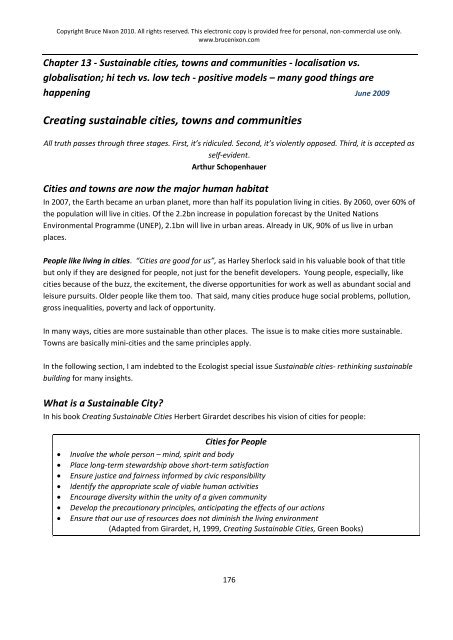A better world is possible - Global Commons Institute
A better world is possible - Global Commons Institute
A better world is possible - Global Commons Institute
You also want an ePaper? Increase the reach of your titles
YUMPU automatically turns print PDFs into web optimized ePapers that Google loves.
Copyright Bruce Nixon 2010. All rights reserved. Th<strong>is</strong> electronic copy <strong>is</strong> provided free for personal, non-commercial use only.<br />
www.brucenixon.com<br />
Chapter 13 - Sustainable cities, towns and communities - local<strong>is</strong>ation vs.<br />
global<strong>is</strong>ation; hi tech vs. low tech - positive models – many good things are<br />
happening June 2009<br />
Creating sustainable cities, towns and communities<br />
All truth passes through three stages. First, it’s ridiculed. Second, it’s violently opposed. Third, it <strong>is</strong> accepted as<br />
self-evident.<br />
Arthur Schopenhauer<br />
Cities and towns are now the major human habitat<br />
In 2007, the Earth became an urban planet, more than half its population living in cities. By 2060, over 60% of<br />
the population will live in cities. Of the 2.2bn increase in population forecast by the United Nations<br />
Environmental Programme (UNEP), 2.1bn will live in urban areas. Already in UK, 90% of us live in urban<br />
places.<br />
People like living in cities. “Cities are good for us”, as Harley Sherlock said in h<strong>is</strong> valuable book of that title<br />
but only if they are designed for people, not just for the benefit developers. Young people, especially, like<br />
cities because of the buzz, the excitement, the diverse opportunities for work as well as abundant social and<br />
le<strong>is</strong>ure pursuits. Older people like them too. That said, many cities produce huge social problems, pollution,<br />
gross inequalities, poverty and lack of opportunity.<br />
In many ways, cities are more sustainable than other places. The <strong>is</strong>sue <strong>is</strong> to make cities more sustainable.<br />
Towns are basically mini-cities and the same principles apply.<br />
In the following section, I am indebted to the Ecolog<strong>is</strong>t special <strong>is</strong>sue Sustainable cities- rethinking sustainable<br />
building for many insights.<br />
What <strong>is</strong> a Sustainable City?<br />
In h<strong>is</strong> book Creating Sustainable Cities Herbert Girardet describes h<strong>is</strong> v<strong>is</strong>ion of cities for people:<br />
<br />
<br />
<br />
<br />
<br />
<br />
<br />
Cities for People<br />
Involve the whole person – mind, spirit and body<br />
Place long-term stewardship above short-term sat<strong>is</strong>faction<br />
Ensure justice and fairness informed by civic responsibility<br />
Identify the appropriate scale of viable human activities<br />
Encourage diversity within the unity of a given community<br />
Develop the precautionary principles, anticipating the effects of our actions<br />
Ensure that our use of resources does not dimin<strong>is</strong>h the living environment<br />
(Adapted from Girardet, H, 1999, Creating Sustainable Cities, Green Books)<br />
176
















